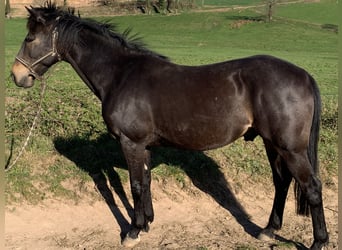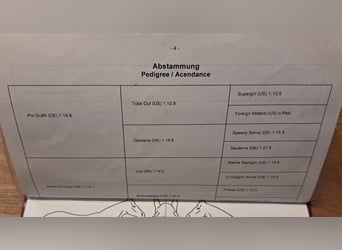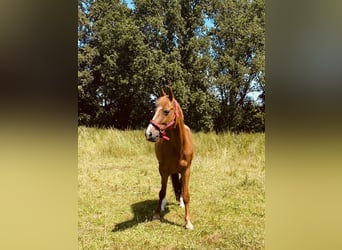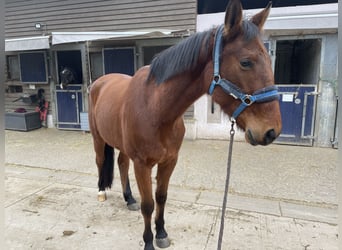FR
French Trotter horses for sale
Page-1-Ad
In addition, interested parties can directly see more information. This significantly increases the number of potential buyers.

FR
FR
AT
FR
DE
FR
FR
FR
NL
DE
FR
DE
NL
FR
FR
FR
The French Trotter was developed in France from a regional breed, the Norman Carossier, and other international trotting horse breeds. It remains a very distinctive type, with its own unique qualities. Although French Trotters are well-known as successful harness racers, many people buy a French Trotter as a riding horse. There is no breed standard for French Trotters, but they are generally strong and handsome horses that reflect their Norman ancestry, and Normandy is still the region with the highest concentration of breeders who will sell a French Trotter. Trotting races have been a popular sport in France since the nineteenth century, and many of the horses are produced by family breeders who also train and race them.
Origin and history of breeding French Trotter horses
The French Trotter breed was developed in France in the nineteenth century at a time when trotting races were a very popular sport. As Normandy had been famous for centuries for the quality of its horses, it is not surprising that some of the foundation stock was from this region. This was the famous Carossier Normand, a fast utility horse for coach and carriage work that was an ancestor of the Norman Cob. Trial trotting races were established as early as 1806 on the Champs de Mars. Crossbreeding with imported stallions to improve the speed of the French Trotters also began early in the nineteenth century, with the arrival of a Norfolk Roadster stallion called The Norfolk Phenomenon, followed by Young Rattler, foaled in 1811. However, selective breeding only began later in the century, with the arrival of Thoroughbred and Hackney stallions and the creation of racetracks at various locations such as Cherbourg, Caen, Saint Lô and Le Pin. As the American Standardbred began to achieve fame, members of this breed were imported too, giving the French Trotters additional speed. The studbook was established in 1906 and closed to non-French breeds in 1937. By the 1960s, French Trotters were competing successfully alongside other international harness-racers. Registration of breeding stock has always been based on performance. The breed also contributed to the creation of the Selle Français riding horse. Crossed with other breeds, the French Trotter produces sport and riding horses of very good quality, retaining the stamina and strength of their Norman ancestors.
French Trotters in equestrianism
In 1901, the French Trotter Képi produced a record-breaking trot of one mile (1.6 km) in 1 minute 27 seconds. There are two major championships, the Prix de Cornulier, which is for ridden trotters, and the Prix d'Amérique for harness horses driven to sulkies, which are light harness-racing vehicles.
Use and characteristics of French Trotter horses
The majority of French Trotters are 15.1 hands (61 inches/155cm) to 16.2 hands (66 inches/168 cm) high. Their coat can be any solid colour. Because there is no breed standard and breeding is mostly a local and regional activity, there is a degree of variation whenever breeders sell a French Trotter. However, strict standards apply for entry into the studbook, based on performance in national or international races. The breed is a true trotter and does not exhibit a lateral pace like the American Standardbred, and so they are a better option for riding. This is because trotting races in France take place under saddle as well as in harness. When equestrians buy a French Trotter, they know the horses have always been bred to be larger and stronger than other trotting breeds in order to carry a rider. French Trotters have good temperaments and are hardy and long-lived.
Interior of French Trotter horses
French Trotters are renowned for their intelligence and trainability, making them an ideal choice for both personal and professional use. They possess a docile disposition that allows them to be handled with ease, while their work ethic allows them to excel in any event requiring speed or stamina. Furthermore, they have an amiable nature which makes them suitable mounts for children and beginners alike - allowing riders of all ages and skill levels to get the most out of these extraordinary horses. In addition to having the brains, French Trotters also have heart - known for their loyalty and willingness to please their owners. This combination of characteristics makes this breed a favorite among riders looking for a faithful partner in the saddle. They are even-tempered and responsive, not easily spooked or provoked by sudden stimuli. Moreover, they exude calmness and composure even in high-pressure situations - something that many other breeds cannot claim! Finally, French Trotters are blessed with good health too! Their healthy joints allow them to perform rigorous activities without suffering major injuries or wear and tear. They also require fewer vet attention than other breeds due to their robust immune systems which is certainly another plus point! All in all, the French Trotter is truly an impressive breed of horse - combining physical beauty with mental prowess to create something truly special!
Exterior of French Trotter horses
French Trotters are known for their classic good looks. They typically stand between 14-16 hands high and have colors that range from chestnut to black. While they do possess an elegant physique, they're also relatively compact - making them nimble enough to perform a trotting gait known as ‘the rack’. Their long manes, tails and feathered legs add further elegance while providing protection from cold climates. Plus, they commonly feature white markings on their faces which only adds to their beauty! When it comes to French Trotters' gaits, they are particularly renowned for the presence of power and energy in each stride. Their strong frames allow for a smooth ride with minimal effort when in motion, giving them a sense of elegance that is unmatched by any other breed. Additionally, because of their short strides and ability to quickly transition between paces, French Trotters are highly sought after for events requiring agility and precision. Overall, French Trotters offer the perfect combination of strength and gracefulness that make them truly unique amongst horse breeds. From their beautiful exterior to their powerful movement, these horses are sure to captivate anyone who admires them!
History of French Trotter horses
French Trotters have a long and distinguished history. They are thought to have originated in France during the 18th century, where they were developed by crossing different breeds of horses including Flemish, Spanish and Arab mares. Their strong work ethic, intelligence and trainability allowed them to be used as riding horses for both military and civilian purposes - something which led to their popularity in Europe and eventually, the United States. In fact, during the American Revolution, French Trotters were widely used for cavalry purposes due to their strength, endurance and reliability in battle. The trait that makes French Trotters so special is their trotting gait known as 'the rack'. This comes from the interweaving of their gaits which gives them speed without sacrificing agility or control - making it perfect for disciplined equestrians who need quick reactions. As a result, trotting competitions quickly became popular activities for people looking to show off their skills with these impressive creatures! Today, French Trotters remain an iconic breed - prized for their elegance and intelligence. They continue to take part in dressage competitions around the world while also providing much-needed companionship to those lucky enough to own one!



































